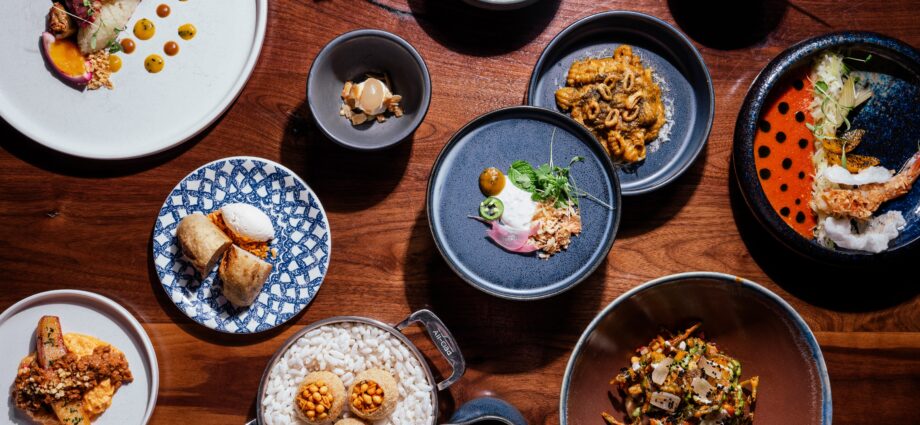Agni‘s tasting menu is shaped by wide-ranging references. Practically every dish served at the Columbus, Ohio restaurant is an homage to a person or place who has inspired a member of the kitchen team.The recipe for Bengali goat curry is sourced directly from chef-owner Avishar Barua’s mother, spooned over a bed of ribbed pasta shells; a rohan duck adobo borrows from the teachings chef de cuisine James Garlock’s Filipino peers from culinary school; and a “Heckuvagood” sauce (adorning a chaat starter course) gestures to the Midwest’s cherished Heluva Good! dip.
Like Barua, Agni is both Bengali-American and unmistakably Midwestern. It’s also deeply influenced by the restaurant’s kitchen team, most of whom hail from Oaxaca. In that spirit, the ever-changing menu may feature a duck mole or a cafe con pan-inspired dessert, conceived with direct input from Agni’s staff.
The kitchen team at Agni.
Photo by Chloe Taddie
The version of Agni’s menu, served in Spring 2024, begins with an idiosyncratic French onion chaat and ends with a cafe con pan bread pudding—fitting, artfully composed bookends for the story that Agni sets out to tell during each meal.
Chaat
Photo by Chloe Taddie
Chaat is a common welcome snack in South Asian homes, and for Barua it’s the ideal starter course. The dish relies on varied textures: a starchy base, crispy toppings, and tangy sauces or chutneys. This twist on French onion soup leans into maximalism with caramelized onion and potato purée, fried spinach and arugula tendrils, crunchy jhalmuri (a Bengali puffed rice mix), and nigella seeds. “The more you add to it, the more cool it becomes,” he says. In that spirit, Barua completes the melange with a trio of drizzles: apple chutney, creamy salsa, and “Heckuvagood” sauce—a homemade riff on the onion dip from Heluva Good, a beloved store-bought, Midwestern brand.
Moqueca de Camarão
Photo by Chloe Taddie
Garlock conceived this course around the holidays with shrimp cocktail in mind. He also drew inspiration from moqueca de camarão, a Brazilian stew, creating an aromatic sauce that combines zingy horseradish with tomatoes, garlic, sherry vinegar, coconut milk, and makrut lime leaf. The prawns pay homage to an unlikely patron saint: the fried shrimp at Red Lobster. They’re coated with crunchy buckwheat and toasted coconut, then plated with melted leeks, shrimp chips, and dots of charred allium oil.
红油餃子 (Red oil dumplings)
Photo by Chloe Taddie
Each of these Sichuan dumplings contains a kebab-spiced lamb filling (based on a family recipe called Ke-Bobby, endearingly nicknamed after Barua’s brother). The wrapper is sealed with seven precise pleats—a technique Barua learned while working at Danny Bowien’s Mission Chinese Food in New York. The dumpling sits atop a bed of charred cabbage and is accompanied by a grilled duck tenderloin skewer. Diners are encouraged to dunk the skewer into the sweet soy sauce swirled with Kashmiri and Tianjin chile oil.
Gosht Jhol
Photo by Chloe Taddie
Barua’s point of view as a Bengali-American chef born and raised in Ohio shines in this melding of two iconic dishes: goat curry and beef stroganoff. The sauce, heartened by tender morsels of goat meat, is his mother’s recipe, and the kitchen staff learns straight from the source: “My mom will come and teach, or we’ll go to her house,” Barua says. Grilled pickled local mushrooms add welcome acidity and texture. Rather than egg noodles or rice, Barua opts for saffron-infused malloreddus—chewy Sardinian semolina shells that create tiny cups to cradle every bite. A side dish of mango chutney, fried shallots, mint, and pickled veg offer cooling counterpoints to the rich curry.
Rohan Duck Adobo
Photo by Chloe Taddie
No matter how Agni’s menu changes season to season, the final savory course is always duck. The one requirement? The dish must “have an anchor in something meaningful to somebody in the kitchen,” Barua says. Here, Garlock leans into flavors first introduced to him in culinary school by a Filipino friend. In this rendition, adobo sauce is reimagined as a reduction of duck stock and traditional elements: cane vinegar, palm sugar, garlic, and soy caramel. Confited duck thighs are rolled into crispy lumpia. Dry-aged duck breast mingles with a koji-pickled duck egg, pickled eggplant, fried garlic, rice, and dots of banana ketchup and coconut mustard.
Cafe Con Pan
Photo by Chloe Taddie
When Garlock and Barua visited Oaxaca earlier this year, they were hosted by their coworkers’ families. Every meal ended with café de olla and pan de mollete—a simple baked roll ideal for dunking in spiced coffee. To bring this bit of hospitality back to Ohio, the chefs collaborated with everyone on staff to compose a cinnamon-and-cocoa-tinged bread pudding (made from leftover sourdough), dulce de leche, coffee shaved ice, cookie crumbles, and clouds of meringue, all dusted with lime zest and pineapple powder. It’s a sweet—and meaningful—final note.

